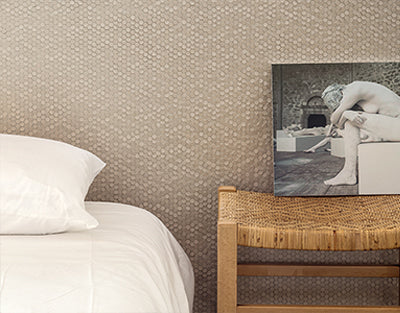
Welcome to the final post of our blog series Luxury Design. The purpose of these posts is to give you an idea of some of the things that set premium tiles apart from all others so you can choose the tile that’s right for you. Today I’d like to talk about Craft & Technique.
When it comes to porcelain and ceramic tile, many materials are produced with a simple production or printing technique. Some luxury tiles, however, undergo a more intricate process, giving the tile more depth, texture and surface interest. Check out a few examples here:
PRODUCTION TECHNIQUE
In this example featuring Phenomenon mosaics, each piece (in the case of Honeycomb, each hexagon,) is individually mounted to a mesh back. If you look at this closely, each piece is like a work of art. Jewelry, almost. And when it’s installed, you won’t see grout joints. When installed correctly, it blends perfectly.
In mass produced, more commodity-style tiles, a similar design (i.e. a hexagon) may be stamped into the surface, which can look a bit more vanilla. Additionally, the final installation will show a visible grout joint.

Stamped tile. Less expensive but will have visible grout joints and a less refined look overall.
PRINTING TECHNIQUE
Let’s take a look at printing technique. In this case, we’re actually comparing one of our standard tiles Origami Noir, to one of our luxury tiles, Piano. The point here is, there’s nothing wrong with basic tiles and production techniques if that’s what your application calls for. (Just make sure it’s suitable for floors if you’re installing it on floors!). But some projects call for a tile that’s more of a boutique tile for that additional wow factor.
In the Origami Noir, an inkjet process is used, which means the pattern is simply printed on the surface of the tile. The tile then goes in the kiln, which essentially “bakes” the pattern onto the surface of the tile. The result is a durable tile with pattern, but a somewhat one-dimensional appearance. You’ll see what I mean when I get to our next example… Piano.
Piano is a partially glazed tile. You’ll see that the use of glaze over just half the tile gives each tile 2 subtle textures and surface variations for a nice contrast in the matte tile and it’s slight sheen glaze. We think these tiles look like candy. Order a sample for yourself and let us know what you think. Please tag us on Insta so we can see your comments and hopefully repost! @missionstonetile.
Inkjet printing technique
Close Up of Piano:

Close Up of Origami Noir:

And that’s a wrap on our Luxury Design series.
What’s right for you? Basic tile? Or luxury tile? Or maybe it’s a bit of both? It’s your design – you get to decide!
Explore all of our Mutina Collections

